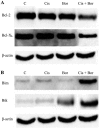Synergistic effects of cisplatin and proteasome inhibitor bortezomib on human bladder cancer cells
- PMID: 26171069
- PMCID: PMC4487089
- DOI: 10.3892/ol.2015.3250
Synergistic effects of cisplatin and proteasome inhibitor bortezomib on human bladder cancer cells
Abstract
The proteasome inhibitor bortezomib is a promising novel agent in bladder cancer therapy; however, inducible cytoprotective mechanisms may limit its potential efficacy. To date, the cellular and molecular effects of proteasome inhibitors on bladder cancer cells have been poorly characterized. Despite the consistent rate of initial responses, cisplatin treatment typically results in the development of chemoresistance, leading to therapeutic failure. Therefore, the present study aimed to characterize the molecular mechanisms underlying the anti-proliferative effects of cisplatin and bortezomib combination therapy on the human T24 bladder cancer cell line, by analyzing the protein expression levels of apoptotic genes. Cytotoxic effects were measured using a water-soluble tetrazolium salt-1 assay, and the apoptosis-associated molecules were examined using western blot analysis and ELISA. It was observed that combined administration of cisplatin and bortezomib induced upregulation of caspase-3, -8 and -9, B-cell lymphoma-2 (Bcl-2)-like 11 and Bcl-2-interacting killer, but downregulated Bcl-2 and Bcl-extra large protein expression levels in T24 cells in a dose-dependent manner. Furthermore, enhanced protein expression of caspase-8 and -9, in line with the significantly increased caspase-3 activation, was detected when the cells were treated with a combination of cisplatin and bortezomib, compared with that of either agent alone. Bortezomib appeared to synergize with cisplatin to promote apoptosis via the extrinsic and intrinsic apoptotic pathways. Taken together, the results of the current study provide the preclinical framework for additional evaluation of the effects of combining bortezomib with other agents to induce apoptosis in bladder cancer cells.
Keywords: apoptosis; bladder cancer cells; bortezomib; cisplatin.
Figures



Similar articles
-
Effects of the proteasome inhibitor bortezomib alone and in combination with chemotherapeutic agents in gastric cancer cell lines.Oncol Rep. 2008 Apr;19(4):1027-32. Oncol Rep. 2008. PMID: 18357392
-
Combined proteasome and Bcl-2 inhibition stimulates apoptosis and inhibits growth in EBV-transformed lymphocytes: a potential therapeutic approach to EBV-associated lymphoproliferative diseases.Eur J Haematol. 2008 May;80(5):407-18. doi: 10.1111/j.1600-0609.2008.01044.x. Epub 2008 Jan 23. Eur J Haematol. 2008. PMID: 18221384
-
Enhanced sensitivity of bladder cancer cells to tumor necrosis factor related apoptosis inducing ligand mediated apoptosis by cisplatin and carboplatin.J Urol. 2001 Jan;165(1):263-70. doi: 10.1097/00005392-200101000-00076. J Urol. 2001. PMID: 11125422
-
Human bladder cancer cells undergo cisplatin-induced apoptosis that is associated with p53-dependent and p53-independent responses.Int J Oncol. 2009 Aug;35(2):401-16. Int J Oncol. 2009. PMID: 19578756
-
Bortezomib targets the caspase-like proteasome activity in cervical cancer cells, triggering apoptosis that can be enhanced by nelfinavir.Curr Cancer Drug Targets. 2011 Sep;11(7):799-809. doi: 10.2174/156800911796798913. Curr Cancer Drug Targets. 2011. PMID: 21762082
Cited by
-
Proteasome Inhibitor MG132 Enhances Cisplatin-Induced Apoptosis in Osteosarcoma Cells and Inhibits Tumor Growth.Oncol Res. 2018 May 7;26(4):655-664. doi: 10.3727/096504017X15119525209765. Epub 2017 Nov 30. Oncol Res. 2018. PMID: 29191257 Free PMC article.
-
Nitric Oxide Generated by Tumor-Associated Macrophages Is Responsible for Cancer Resistance to Cisplatin and Correlated With Syntaxin 4 and Acid Sphingomyelinase Inhibition.Front Immunol. 2018 May 29;9:1186. doi: 10.3389/fimmu.2018.01186. eCollection 2018. Front Immunol. 2018. PMID: 29896202 Free PMC article.
-
PDK2 leads to cisplatin resistance through suppression of mitochondrial function in ovarian clear cell carcinoma.Cancer Sci. 2021 Nov;112(11):4627-4640. doi: 10.1111/cas.15125. Epub 2021 Sep 13. Cancer Sci. 2021. PMID: 34464482 Free PMC article.
-
Synergic effect of anticancer peptide CIGB-552 and Cisplatin in lung cancer models.Mol Biol Rep. 2022 Apr;49(4):3197-3212. doi: 10.1007/s11033-022-07152-3. Epub 2022 Jan 30. Mol Biol Rep. 2022. PMID: 35094208
-
Proteasome Inhibitor YSY01A Enhances Cisplatin Cytotoxicity in Cisplatin-Resistant Human Ovarian Cancer Cells.J Cancer. 2016 Jun 6;7(9):1133-41. doi: 10.7150/jca.14519. eCollection 2016. J Cancer. 2016. PMID: 27326257 Free PMC article.
References
-
- da Silva GN, de Castro Marcondes JP, de Camargo EA, da Silva Passos Júnior GA, Sakamoto-Hojo ET, Salvadori DM. Cell cycle arrest and apoptosis in TP53 subtypes of bladder carcinoma cell lines treated with cisplatin and gemcitabine. Exp Biol Med. 2010;235:814–824. doi: 10.1258/ebm.2010.009322. - DOI - PubMed
-
- Köberle B, Tomicic MT, Usanova S, Kaina B. Cisplatin resistance: Preclinical findings and clinical implications. Biochim Biophys Acta. 2010;1806:172–182. - PubMed
LinkOut - more resources
Full Text Sources
Other Literature Sources
Research Materials
